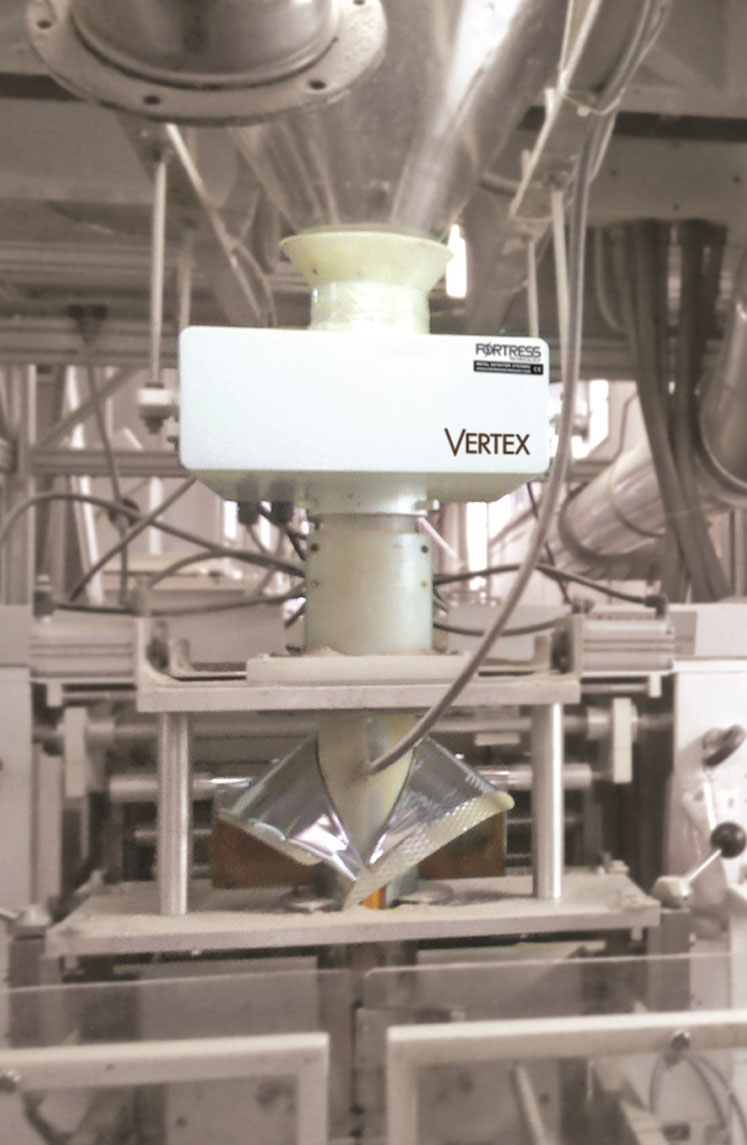Fortress Technology examines why its top selling Vertex Metal Detector, equipped with Halo automatic testing, is catering to this 4.1% year-on-year revenue rise.
Designed specifically to inspect free-falling snacks and ingredients, more than 700 new Vertex metal detection units from Fortress Technology were installed by snack manufacturers globally in 2019. Buyers ranged from some of the largest international food brands to fast-expanding niche snack factories.
Protecting valuable snack, pretzel, nuts, popcorn, cereal and corn and potato crisp brands by supporting fast product changeovers, the Vertex unit when fitted with Halo reduces the time food factories dedicate to performing frequent routine verification checks. As many snack manufacturers have discovered, they swiftly realise major labour cost savings.
Fitting into restricted production spaces where other detectors can't, the inline system is designed to integrate with Vertical Form Fill Seal (VFFS) pouch-packing solutions. With a case through dimension that can be as little as 125 mm (191 mm including flanges) and a circular aperture, the Vertex easily slots into existing VFFS packaging and weighing turnkey lines to enhance quality and consumer confidence.
The only known food metal detector of its kind that incorporates an advanced automatic testing program, the compact throat unit also increases production capacity and addresses staff shortages.
Security for super snackers
Fuelled by consumer ‘snackification’ demands for quick, on-the-go foods, snack brands are continually innovating and diversifying product portfolios. Although considered by many to be discretionary purchases, the snack market continues to expand. Western Europe is the third-largest region in the global savoury snacks sector and is expected to grow from $20,985.0 million in 2018 to $25,403.6 million by 2023, at a CAGR of 3.9%.
Documenting the rise of the ‘super snacker’, Frito-Lay recently published its top 2020 forecasts indicating that spice, citrus, global influence, unexpected combinations and health benefits will drive new product developments (NPD).
With snacks becoming such a mainstream mode of eating, a number of manufacturers in the snack space are swiftly tapping into these trends and adding more packing and inspection lines, observes Fortress Technology’s European Managing Director Phil Brown. He notes that it’s not unusual to see up to 200+ turnkey weighing, metal detectors and VFFS packing lines side-by-side in large snack factories.
Phil explains: “The addition of new ingredients, flavours, own-label, sub-brands, pack sizes and nutritional concepts means that a snack company’s average portfolio can easily comprise 100+ Stock Keeping Units (SKUs).”

Vertex with the addition of Halo is pretty much an off-the-shelf metal detector, enabling snack manufacturers to rapidly introduce new lines and speed up their time to market. Similarly, the aperture sizes tend to be quite standard. “Small enough in diameter to ensure metal detection sensitivity is not compromised, yet wide enough to ensure there’s no product choke-off,” adds Phil.
Despite its slim stature, the Vertex meets, and in many instances exceeds, the sensitivities of comparable snack metal detection systems. Utilising the very latest Digital Signal Processing technology, each unit inspects freefalling product at high speeds, detecting and rejecting the smallest metal contaminants including pieces of wire, shavings and swarf.
Rather than adding a side reject system, which would be too bulky for most snack packing lines, when the Vertex identifies a metal contaminant, a signal is sent to the PLC, or to the downstream bagging equipment. Typically, the reject output is connected to the bagger, which then either stops the line or inhibits the cutting of bags.
This means the contaminant is trapped and sealed in an extra long bag that is easily spotted and removed by personal, or more typically by a downstream checkweigher, which will reject it as overweight.
The Vertex can also be utilised to avoid issues that may arise when inspecting sealed products in metallised polybags. It is also possible to inspect for metal in a metallised bag. Phil explains: “The achievable sensitivity will mostly depend on the characteristics of the bag, which product tests performed free of charge by Fortress can determine.”
Say Halo!
Naturally, snack manufacturers may worry when metal contaminants are detected. But equally they may be concerned if their metal detector hasn’t picked anything up for a while. It’s why performance checks are conducted at regular intervals, typically hourly, on inspection machinery.
Owing to the scale of their automated weighing, inspection and packing operations, automatic testing is widely adopted by the snack community. As well as reducing the cost associated with performing these checks manually, automatic testing improves the repeatability of routinely monitoring a metal detector’s performance.
Halo is Fortress’ version of automatic testing. It works by repeatedly and accurately simulating testing with all metal types (ferrous, non-ferrous and stainless-steel) by mimicking the signal disturbance of particles of a calibrated size. Each Halo, which is a separate kit of electronics from the search head, is calibrated to simulate the presence of a metal contaminant falling at the speed of the application being inspected.
Phil comments: “Turnkey vertical packing lines are compact and make access even more challenging for performing good quality checks. To test the worst-case scenario, metal test pieces would need to pass through the exact centre of the Vertex aperture tube."
"It is always good practice to challenge the metal detector in a way that simulates the speed in which product is passing through the machine and the hardest to detect scenarios, which manual checks don’t do consistently. The result may be a false sense of security that the metal detector is reliably detecting to the desired performance level.”
Multiple machines can be networked to generate a site performance due diligence report. “We are not aware of any other technology in the food inspection market that can test all sizes and metal types so reliably, precisely and at such a fast speed,” states Phil.
The impact Halo can have on cost of ownership is easy to see. Most large snack processing lines performing manual tests have two people dedicated just to this task. One to insert and another to remove, document and report the test. If testing 100+ metal detectors at the start, end and throughout a shift (often hourly) and after every product changeover, the costs soon climb, and the possibility of human error also rises.
As a relatively inexpensive metal detector, Phil is quick to point out that for any food company brand protection is critical. “The quality and brand stakes in snacks are high. Vertex equipped with Halo offers snack manufacturers a fast return on investment in a rapidly evolving market where product costs and production speeds continue to rise.”




